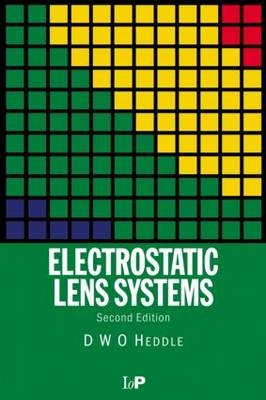
Electrostatic Lens Systems, 2nd edition
Seiten
2000
|
2nd edition
Institute of Physics Publishing (Verlag)
978-0-7503-0697-3 (ISBN)
Institute of Physics Publishing (Verlag)
978-0-7503-0697-3 (ISBN)
- Titel ist leider vergriffen;
keine Neuauflage - Artikel merken
Helps readers to design lens systems for focusing beams of charged particles that have useful characteristics. This book covers the basic theory of the motion of charged particles in electrostatic fields and describes various methods for the calculation of the potential and field distribution for various electrode geometries.
Electrostatic Lens Systems: Second Edition enables readers to design lens systems for focusing beams of charged particles that have useful characteristics. The book covers the basic theory of the motion of charged particles in electrostatic fields and describes several methods for the calculation of the potential and field distribution for various electrode geometries. It emphasizes the Bessel function expansion method, developed by the author and his students, and the nine-point implementation of the finite difference method. Demonstration programs of other methods can be found via the websites provided. A chapter on aberrations presents formulae that enable the coefficients to be determined by an extension to the ray tracing procedures, demonstrating optimum conditions for lens operation.
The book is accompanied by a disk that provides a suite of computer programs (LENSYS for MS-DOS) intended for practical use in the design and analysis of systems using round lenses with apertures or cylindrical elements. These programs are of value even to experienced workers in the field who may be quite familiar with much of the material in the text.
Electrostatic Lens Systems: Second Edition enables readers to design lens systems for focusing beams of charged particles that have useful characteristics. The book covers the basic theory of the motion of charged particles in electrostatic fields and describes several methods for the calculation of the potential and field distribution for various electrode geometries. It emphasizes the Bessel function expansion method, developed by the author and his students, and the nine-point implementation of the finite difference method. Demonstration programs of other methods can be found via the websites provided. A chapter on aberrations presents formulae that enable the coefficients to be determined by an extension to the ray tracing procedures, demonstrating optimum conditions for lens operation.
The book is accompanied by a disk that provides a suite of computer programs (LENSYS for MS-DOS) intended for practical use in the design and analysis of systems using round lenses with apertures or cylindrical elements. These programs are of value even to experienced workers in the field who may be quite familiar with much of the material in the text.
The optics of simple lenses. The motion of charged particles in an electrostatic field. The determination of the axial potential. The optics of simple lens systems. Aberrations. The LENSYS program. Technical aspects of LENSYS. References.
| Erscheint lt. Verlag | 13.12.2000 |
|---|---|
| Zusatzinfo | 42 Illustrations, black and white |
| Verlagsort | London |
| Sprache | englisch |
| Maße | 156 x 234 mm |
| Gewicht | 420 g |
| Themenwelt | Naturwissenschaften ► Physik / Astronomie ► Optik |
| ISBN-10 | 0-7503-0697-1 / 0750306971 |
| ISBN-13 | 978-0-7503-0697-3 / 9780750306973 |
| Zustand | Neuware |
| Haben Sie eine Frage zum Produkt? |
Mehr entdecken
aus dem Bereich
aus dem Bereich
Grundlagen - Verfahren - Anwendungen - Beispiele
Buch | Hardcover (2022)
Hanser, Carl (Verlag)
49,99 €
Grundlagen und Anwendungen
Buch | Hardcover (2023)
Hanser, Carl (Verlag)
59,99 €


